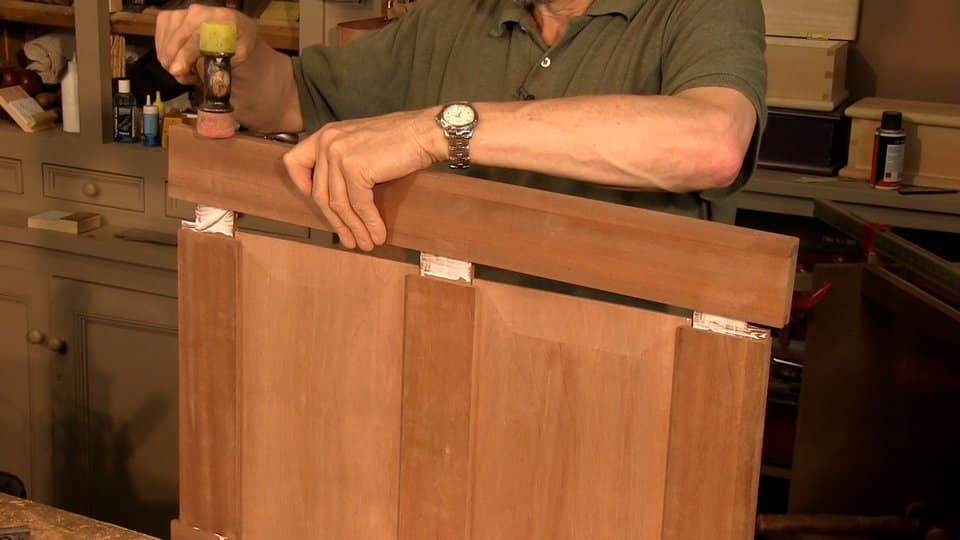Tool Chest: Episode 8
Posted 4 September 2013
This is an episode in a paid series. Want to watch it? You just need to sign up as a paid member, and you can enjoy this video and many other videos we think you will love.
In this episode Paul assembles the top frame with it’s two raised panels and shares some tips on safe assembly. Paul also glues and clamps the assembly.


Nice job guys, thanks for this one ;`)
Another great video, I am learning so much Thanks Everyone. I can’t wait to start mine here very soon.
Steve
I really appreciate the details on sanding, scraping and a dry run before the glue up.
What happened? Episode 7,6,5,… were fine, great color and detail. Now, Episode 8 is black and white on the left and green stripes on the right. Are you using a different type of video file? I would attach a screen print but I dont see how on this page.
Video looks great here. No color issues, or any issues.
Paul, once again, it is a pleasure to watch you work and learn from you.
Hi Larry, Sorry that you have had a problem with the video. Everything looks fine. Hopefully it was a temporary issue.
Paul,
What are your thoughts regarding pre-finishing the panels before glue-up? If the finish is applied to the panel and frame after glue-up, when the panels change dimensions throughout the seasons, at times you will see unfinished areas of the panel.
I’ve only made a few frame and panel pieces (with machines), but I always followed that rule-of-thumb.
Thanks
Great question Marty, I was wandering exactly the same thing.
Another great video though. Masterclasses is proving to be excellent and the way the techniques are pulling together into gradually more complex projects.
Thanks Paul, Joseph, Phil and the rest of your team
It depends on the finish and the dryness of the wood. Prefinishing panels works fine and yes there is the issue of shrinkage regardless of finish choice, but sometimes I prefinish and sometimes not. Depends on my mood, time and whether I think shrinkage will be an issue. Sometimes it is easier to finish panels before installation, but not usually in the middle of making a video on construction methods. Also, it depends on the wood too. Softwoods move more than the hardwood mahoganies. Mahogany moves only minimally and I doubt that I will face shrinkage issues that would cause any concern.
Thanks for the reply Paul.
I certainly understand the ‘middle of making a video’ issue 🙂 Yet you do spend a fair amount of video time showing the entire finishing process for the projects that I’ve watched. Maybe in a future project involving panels you could speak to the subject for a few minutes, even if you don’t actually pre-finish due to scheduling issues.
The following isn’t meant to be argumentative. The mere fact that frame and panel construction is used is because of wood movement, right? So if you’ve decided that wood movement for a particular wood (all woods probably) requires frame and panel construction, then the panels are going to move, and unfinished areas could be a problem.
Yet clearly you don’t always do this. I guess this is a case where theory doesn’t match real-world experience.
I now see that it’s a complicated subject that doesn’t lend itself to an answer here. I guess the answer that I’ll take away is, always pre-finish if you have the time.
Prefinishing can interfere with the final dimensioning of the pieces, especially the floating panels. You also have to be careful to not get the finish on the jointing surfaces to avoid glueup issues.
I believe the question/suggestion was to apply finish to the panels only, before assembly. That allow full finish to the edges of the panel. There is not need to pre-finish the frame in this case and since the panel is not (at least typically should not be) glued tot he frame, there is not concern about finish on the entire panel. If you know that the panels are at there smallest size, I suppose no need to pre finish, and also in some areas where there is little humidity change. But for safety I almost always prefinish panels. One less thing to worry about . . .
Hello Paul, I have always wanted to ask you for the real necessity of rough sanding a previously planed surface. I know you say it is to improve the adhesion of the finish. But I’ve always disliked the idea of roughing one pristine surface that took me good effort. So, on some furniture I’ve made, I have not roughen the surfaces at all, and yet didn’t notice any adhesion problems. In that situation I have used Shellac and also Nitrocellulose as sealer and as lacquer.
Should I still be worried about the durability of those because of the lack of rough sanding? Have you finished some furniture without the sanding?
Thank you very much.
@ telek
I have also wanted to ask the question you asked above. I often feel the same way about sanding/roughing a project that I’ve spent considerable time sharpening (the plane iron & scraper edges) to precision & planing/cabinet “scraping” to achieve a pristine, glass-smooth, beautiful surface on the wood. I have also decided to not sand several projects where I just couldn’t bring myself to sand those amazing looking planed surfaces, and I’ve had no issues with shellac or lacquer or even grain filler adhering to the planed surfaces. Maybe it’s a longevity issue; as those particular projects are at most under a decade old so far.
Also, I recognize that sanding does reveal flaws in what may appear to be a perfect surface which I usually encounter with difficult-grain woods.
I realize it’s eight years later, but I still ponder this issue.
I hope all is well, take care,
Derek P.